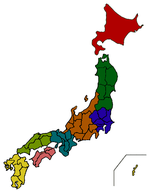Related Research Articles
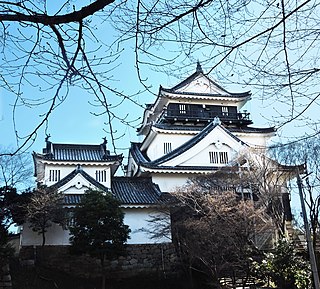
Okazaki Castle is a Japanese castle located in Okazaki, Aichi Prefecture, Japan. At the end of the Edo period, Okazaki Castle was home to the Honda clan, daimyō of Okazaki Domain, but the castle is better known for its association with Tokugawa Ieyasu and the Tokugawa clan. The castle was also known as "Tatsu-jō " (龍城).
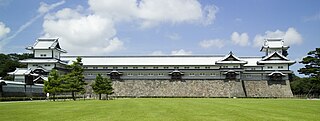
Kanazawa Castle is a large, partially-restored Japanese castle in Kanazawa, Ishikawa Prefecture, Japan. It is located adjacent to the celebrated Kenroku-en Garden, which once formed the castle's private outer garden. It was the headquarters of Kaga Domain, ruled by the Maeda clan for 14 generations from the Sengoku period until the coming of the Meiji Restoration in 1871.

Iwamura Castle was located in the southeastern area of Mino Province in Japan. Its ruins can be found in the modern-day municipal subdivision of Iwamura, in Ena, Gifu Prefecture. Along with Takatori Castle in Nara and Bitchu-Matsuyama Castle in Okayama, it is regarded as one of the three best mountain castles, and at an elevation of 721 meters above sea level, it is one of the highest in Japan.
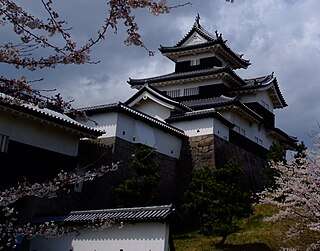
Komine Castle is a Japanese castle located in what is now the city of Shirakawa, southern Fukushima Prefecture, Japan. Throughout the middle to later Edo period, Komine Castle was home to the Abe clan, daimyō of Shirakawa Domain. It was also referred to as Shirakawa-Komine Castle or simply Shirakawa Castle. The castle is one of the 100 Fine Castles of Japan, and in 2007 was designated a National Historic Site. It should not be confused with the older Shirakawa Castle also located in Shirakawa, Fukushima, also known as Karame-jō (搦目城) or Yūki-Shirakawa-jō (結城白川城). The castle grounds are also a noted venue for viewing sakura in spring.

Sasayama Castle is an early Edo Period Japanese castle located in the city of Tamba-Sasayama, Hyōgo, Japan. It ruins have been protected as a National Historic Site since 1956.

Aoba Castle is a Japanese castle located in Sendai, Miyagi Prefecture, Japan. Throughout the Edo period, Aoba Castle was home to the Date clan, daimyō of Sendai Domain. The castle was also known as Sendai-jō (仙台城) or as Gojō-rō (五城楼). In 2003, the castle ruins were designated a National Historic Site.

Kōriyama Castle was a Japanese castle in what is now the city of Yamatokōriyama, Nara Prefecture, Japan. The Sengoku daimyō Tsutsui Junkei started construction of the castle, and Toyotomi Hidenaga made it his residence. In the Edo period, it became the headquarters of the Kōriyama Domain. During this time it was held by members of the Mizuno, Okudaira Matsudaira, Honda, Fujii Matsudaira, and Yanagisawa clans.

Matsusaka Castle was a Japanese castle located in the city of Matsusaka, Mie Prefecture, Japan. Throughout most of the Edo period, Matsusaka Castle was a secondary administrative center for the Kishu-Tokugawa clan, daimyō of Kishū Domain. It has been protected as a National Historic Site since 2011.
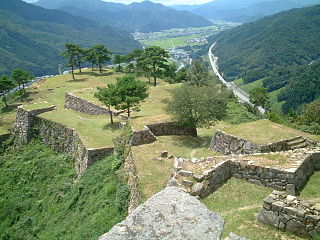
Takeda Castlewas a Sengoku period Japanese castle located in the Wadayama neighborhood of the city of Asago, in the northern part of Hyōgo Prefecture, Japan. It is located north of Himeji, and north-west of Kyoto, and is situated some 353 metres above sea level It is often referred to locally as the "Machu Picchu of Japan". Its ruins have been protected as a National Historic Site since 1943.
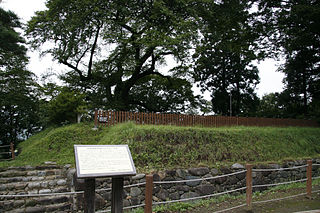
Numata Castle is a Japanese castle located in Numata, northern Gunma Prefecture, Japan. At the end of the Edo period, Numata Castle was home to the Toki clan, daimyō of Numata Domain, but the castle was ruled by various clans over its history, and is noted as the site of a major battle in the Sengoku period. The castle was also known as "Kurauchi-jō" (倉内城).

Hitoyoshi is a 12th-century castle, now ruins, located in Hitoyoshi, Kumamoto Prefecture. It is recognized as one of Japan's top 100 castles.

Sakura Castle was a 17th-century castle, now in ruins, in Sakura, Chiba Prefecture. It was designated one of Japan's Top 100 Castles by the Japanese Castle Foundation.

Tsuwano Castle was a mid-size castle, now ruins, in Tsuwano, Shimane Prefecture, Japan.

Tsutsujigasaki Castle was the fortified residence of the final three generations of the Takeda clan, located in the center of the city of Kōfu, Yamanashi Prefecture, Japan. It is not a Japanese castle in the proper sense of the word, and is not referred to as a "castle" in Japanese, as it was famously the policy of the Takeda clan to "make men your castle, men your walls, men your moats". Nevertheless, it is listed as one of Japan's Top 100 Castles. The ruins have been protected as a National Historic Site since 1938. The site is open to the public and now contains the Takeda Shrine, a Shinto shrine dedicated to the deified spirits of the Takeda clan.

Amagasaki Castle was a 16th-century flatland type castle, in Amagasaki, Hyōgo Prefecture, Japan. It is now in ruins.
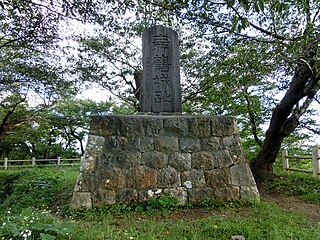
Murakami Castle is a Japanese castle located in Murakami, northern Niigata Prefecture, Japan. At the end of the Edo period, Murakami Castle was home to a cadet branch of the Naitō clan, daimyō of Murakami Domain under the Tokugawa shogunate. The castle was also known as "Maizuru-jō" (舞鶴城). The ruin been protected as a National Historic Site since 1993. It is about 30 minutes on foot from Murakami Station on the JR East Uetsu Line.

Sannohe Castle was a Muromachi period Japanese castle located in what is now the town of Sannohe, in Sannohe District of Aomori Prefecture, in the Tōhoku region of far northern Japan. It was located on a river terrace of the Mabechi River, which formed part of its natural defenses.

Ichinomiya Castle is a mountaintop castle in Tokushima, Japan.

The Ogasawara clan castle sites were a number Sengoku period yamashiro-style Japanese castles located in what is now part of the city of Matsumoto, Nagano prefecture. These fortifications were built in the Muromachi period by the Ogasawara clan, who ruled the area at the time. Two of the castle ruins, that of Igawa Castle and Hayashi Castle, have been protected collectively as a National Historic Sites since 2017.

Kanbe Castle is a Japanese castle located in the city of Suzuka, northern Mie Prefecture, Japan. At the end of the Edo period, Kanbe Castle was home to a cadet branch of the Honda clan, daimyō of Kanbe Domain.
References
- ↑ "Takatori Castle". JCastle, Guide to Japanese Castles. Retrieved 25 June 2016.
- ↑ "Takatori Castle Profile". www.jcastle.info. Archived from the original on 2012-10-25.
- ↑ "Site of Takatori Castle: the Best Mountain Castle of Japan". Asuka Area Administrative Area. Retrieved 25 June 2016.
